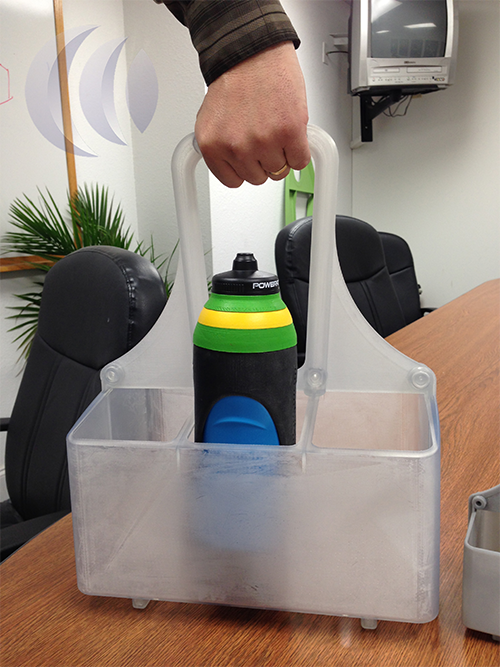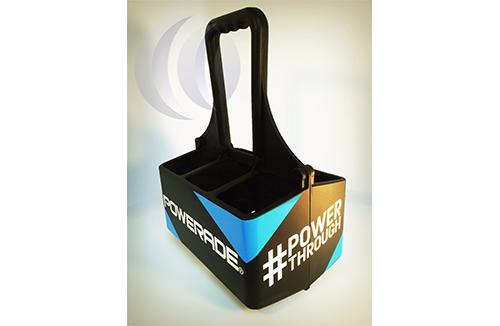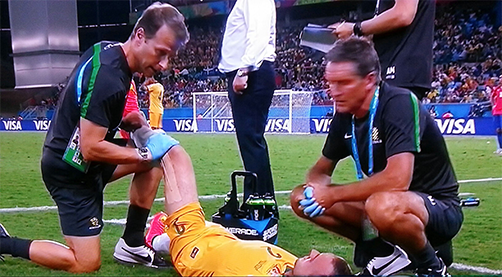In February 2014, the team at American Precision Prototyping (APP) was presented with a unique challenge: redesign, prototype, cast, decorate and ship 150 cast urethane bottle carriers for POWERADE® to be used as promotional equipment in the 2014 FIFA World Cup. And complete the entire job in 30 days. Using a combination of CAD, SLA 3D printing and some slick thinking, the team completed the job with days to spare.
Design and 3D CAD
At the start of this project, the team at APP were supplied with two earlier POWERADE® carrier designs from which to work.
The first was a carrier from the 2012 UEFA European Championship, and the second was a carrier from a U.S. tournament. The client’s goal for the design of the new World Cup carrier was to combine the ergonomics of the US carrier’s design with the overall size and shape of the UEFA carrier. The team needed to start the design from scratch.
Given the short timelines, APP allotted only a week for the concept design phase and this included getting approvals from POWERADE®. As part of the design, the customer wanted the final product to be split in half, with snap-fit connections on each side to create a six-bottle holder. As the team jumped in, they quickly came up with a concept that met the client’s standards for size, ergonomics, and construction, i.e., the six-bottle carrier concept used two identical halves that could easily be snapped and screwed together to make one sturdy carrier.
To ensure the concept was functional, the team at APP 3D printed a half-scale model of the carrier using 3D Systems' SLA technology. This model was used as a proof-of-concept and for general fit checks in the design. It was printed in about 9 hours and sent directly to the customer for review and approval.
“We chose SLA using the iPro 8000 machine to complete this stage for several reasons,” said Jason Dickman, president of American Precision Prototyping. “First, SLA allows for high precision in the produced parts, with tolerances usually within .005 inches. Second, SLA offers a good mix of speed and accuracy, meaning we could complete the initial concept prototypes quickly and get them approved faster.”

Marketing executives from The Coca-Cola Company reviewed the half-scale model and made minor changes, which were input directly into the 3D CAD file. The team then proceeded to make full-scale SLA parts out of the Accura 60 resin material which took about 15 hours for 2 parts each batch. These were used as final fit check parts and mold masters for the silicone molding and casting process.
“We printed out six mold masters in less than a couple of days, from which silicone molds were created for the production phase of the bottle carriers,” says Dickman. “We could never have done this kind of turnaround of mold masters with traditional processes. 3D printing totally made the difference with this project.”
Molding and Casting
Most plastic parts are made using injection molding, a manufacturing technique where melted plastic is injected into a metal mold in the shape of the desired part. Because each part must be ready to use, the molds must be machined very precisely. This is a time-consuming and involved process. It is also expensive, making it impractical for short production runs.

Instead of injection molding, APP’s build team used RTV silicone molding to create the parts. Silicone molding is similar in concept to traditional injection molding, but instead of a painstakingly tooled metal mold, it uses a flexible silicone mold to produce parts. These molds are much faster to manufacture and still produce great results for short product runs. And because the silicone tools are flexible, they also allow for the production of undercuts and for more difficult geometries than a traditional injection mold.
Before making the silicone tools, APP prepped the SLA resin master parts by sanding and finishing them to achieve a finish and texture similar to an injection-molded part.
Said Dickman, “This allowed us to simulate the look and feel of a mass-produced product without sacrificing build time. It also allowed us to build a product that would not need any additional painting or finishing, and would be tough enough for the World Cup teams to use throughout the tournament.”
For the parts themselves, the APP team used InnoTuf® TP-4050 Impact-Resistant Polyurethane to simulate the feel of injection-molded plastic. This material, supplied by Innovative Polymers, was recommended for its excellent impact resistance, flexural strength, and ease of use. The final results speak for themselves, and the team and customer were extremely pleased with the way the material performed under our tight deadlines.
The American Precision team manufactured the 300 necessary carrier halves, which would ultimately be assembled into the 150 beverage carriers. Each tool would need to produce 50 high-quality parts, and they had to look perfect and be ready to assemble straight from the mold.
Art and Assembly
With about two weeks left of the total four, APP began to cast and assemble the 300 parts into finished carriers.
“Because of the accuracy of our initial SLA concept designs, we were able to produce cast urethane parts that needed only minimal post-processing, mostly removing the vents, gates, and flash from the parts,” said Dickman. “After finishing, the parts were ready to be snapped and screwed together, then decorated, packed, and shipped.”
The APP team worked in dedicated round-the-clock shifts to produce and finish 40 to 50 castings per day before finally moving onto the final stage, decoration. Each carrier was decorated with a set of pre-designed vinyl decals displaying the POWERADE® brand name and a dedicated 2014 World Cup twitter hashtag. They can now be seen in the hands of World Cup players from around the globe as they compete in Brazil.
“Without the fast and accurate 3D printing using 3D Systems’ SLA technology, there would have been no way to get this done within the tight timeline,” said Dickman. “We managed to pull off an amazing project in no time at all using 3D printing, and the ingenuity of my team was astounding to see.”

